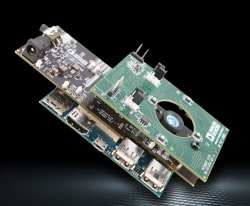Smart sensing technologies are being introduced into healthcare products and devices to enrich user experiences and deliver superior functionalities.
Some of the engineering challenges that product designers often face include how to choose the right intelligent sensing technology; how to best to integrate hardware system and AI algorithm so that sensory data can be translated into meaningful insights. They also struggle how to accelerate the engineering design cycle and minimise development costs.

At the recent Consumer Electronics Show (CES) in Las Vegas earlier this month, Arrow Electronics has demonstrated the first healthcare-focused proof-of-concept design incorporating Analog Devices' 3D time-of-flight (ToF) technology, which could help product designers address these challenges.
Powered by intelligent sensing algorithm, the design demonstrates how 3D ToF technology can be deployed to deliver highly accurate, up to nanosecond real-time sensory data for monitoring breathing pattern and small motion detection.
This integrated design will be used by Hubble Connected, an IoT platform that provides connectivity and services to Motorola-branded smart nursery products, to create these intelligent and intuitive nursery products.
"We appreciate Arrow's support in jump-starting our innovation cycle by developing an integrated platform that combines Analog Devices' latest depth-sensing technology, powerful computing module, and intelligent sensing algorithms to enable smarter and more intuitive features for next-generation health monitoring products. This solution gives room for future custom development within the AI deep learning space," said Feynman Li, CEO of Hubble Connected.
Expanding the use of ToF to a broad range of applications
ToF principle is a method of measuring how long a light signal travels between a sensor and an object. It creates a depth mapping of objects within the field of view and is a key technology used for developing digital vision, delivering high precision, sub-nanosecond real-time sensory data, overcoming signal disturbance challenges.
In the past, Analog Devices’ 3D depth-sensing technology is primarily used in industrial environments as well as autonomous vehicles and smart city applications, according to Kris Lokere, technical director of the Broad Market at Analog Devices said.
“This high-resolution imaging technology enables contact-free and non-invasive measuring of sensory data regardless of the lighting conditions. We look forward to working with Arrow to expand the use of ToF to a broad range of applications, including healthcare monitoring,” he said.
CUHK to help on the solution’s AI capability
Collaborating with Arrow Electronics, Professor Guoliang Xing of the Chinese University of Hong Kong (CUHK) is the principal researcher for developing the intelligent sensing algorithm for this design.
"We are excited to apply our AI research and development work to power a commercial application. Sensing technology is key to capturing accurate and ubiquitous data needed for harnessing the power of AI and deep-learning technologies,” he said.
He added that this combined capability provides devices with the ability and intelligence to analyse data, identify hidden patterns, make classifications, and predict future outcomes with improved accuracy overtime."
To accelerate the design development phase, Arrow's engineers worked closely with Hubble Connected and CUHK research team to address various engineering challenges.
"As a global technology company, we are able to aggregate the solution with deep engineering expertise and broad technology portfolio to help innovators such as Hubble Connected create, make and manage complex integration of advanced electronics and AI technologies so that they can focus on their core competence in delivering extraordinary healthcare products into the hands of consumers," said Jacky Wan, Arrow's vice president of engineering for Asia Pacific region.
To help engineers accelerate prototyping and product development activities using ADI's 3D ToF technology, Arrow now offers an evaluation kit which includes the AD-96TOF1-EBZ mezzanine card, a complete analog front end (AFE) from ADI, along with a Qualcomm DragonBoard 410c.



